|
Wine coolers for individual bottles on the table
first appear in the late 17th century but remained rare until the late
18th century. Most of the surviving examples are made of 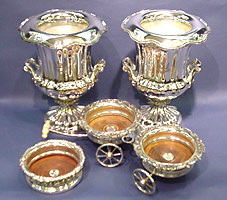 Old
Sheffield Plate and after 1840 of electroplated silver. Few solid silver
coolers were made due to their extraordinary cost. Old
Sheffield Plate and after 1840 of electroplated silver. Few solid silver
coolers were made due to their extraordinary cost.
The usual form, then as now, is the "Campana"
which is shaped like an inverted bell supported on a stemmed circular
foot, much like a small metal garden urn. Another popular form since
the late 18th century is the outwardly sloping straight sided model
which resembles a bucket. (Hence the alternate term for cooler becomes
bucket.)
Coolers are generally fitted with a flat collar
over the top covering the cavity between the exterior wall and a fitted
interior canister for placing the bottle. This provides space for packing
crushed 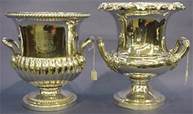 ice
separate from the bottle. ice
separate from the bottle.
Although the earlier Old Sheffield Plate coolers
are considered more desirable, the mid and later 19th century electroplated
coolers are often of great quality and interesting design. Engraved
crests and coats of arms often proclaim the original owner's heritage
and add further interest to the useful and decorative cooler.
Introduced in England by the 1730's the bottle ticket,
as the wine label then was known, served to identify the wine brought
to the dining room. By this time it had been noticed that wines improved
with  the
keeping, so it was binned or stored in the cellar for varying lengths
of time before being brought to the table. The crude bottles of the
period could hardly be introduced to the dining room from the cellar,
therefore the wine was decanted into suitable containers and identified
for content. Hence the blown glass decanter and its accompanying label
in silver. the
keeping, so it was binned or stored in the cellar for varying lengths
of time before being brought to the table. The crude bottles of the
period could hardly be introduced to the dining room from the cellar,
therefore the wine was decanted into suitable containers and identified
for content. Hence the blown glass decanter and its accompanying label
in silver.
Wine drinking developed certain rites which necessitated
a number of decorative accessories in silver. One can follow decorative
stylistic trends of the designs of the wine label from the 1730's to
the middle of the 19th century. By the third quarter of the 19th century
manufacture of wine labels appears on the decline, partly due to the
increased use of presentable, labeled bottles from the wine merchants
and probably saturation of the label market in the past.
Wine labels and labels with names are fascinating
to collect both for their information and decoration. Labels with the
names of liquors, punches and condiments (for cruet bottles) add to
their interest.
|

Dinner is finished, the cloth removed from the table
and servants dismissed from the dining room. Now the decanters of port
and madeira, nestled in their decorative silver coasters, may be slid
along the table to each remaining diner.
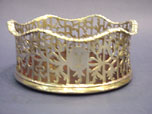 The
above scene would have been the "norm" in prosperous 18th
and 19th century households. Today we use the wine coaster throughout
the meal and after whether upon a bare table or clothed one. Wine or
bottle sliders and decanter stands were earlier names for our coaster.
The bottles or decanters in their coasters would have borne silver wine
tickets or labels identifying the vinous contents. Late 18th and 19th
century coasters range from straight to flaring sides as the use of
bulbous decanters increased. The circular wood bases are turned and
prevent the bottle or decanter, when lifted, from sticking to the coaster.
A silver button in the center could be engraved with initials or the
family crest. The
above scene would have been the "norm" in prosperous 18th
and 19th century households. Today we use the wine coaster throughout
the meal and after whether upon a bare table or clothed one. Wine or
bottle sliders and decanter stands were earlier names for our coaster.
The bottles or decanters in their coasters would have borne silver wine
tickets or labels identifying the vinous contents. Late 18th and 19th
century coasters range from straight to flaring sides as the use of
bulbous decanters increased. The circular wood bases are turned and
prevent the bottle or decanter, when lifted, from sticking to the coaster.
A silver button in the center could be engraved with initials or the
family crest.
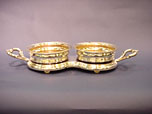 About
1800 the occasional joining of two coasters created the wagon or trolley
with wheels or casters. Single coasters were also fitted with wheels
to create a chariot. About
1800 the occasional joining of two coasters created the wagon or trolley
with wheels or casters. Single coasters were also fitted with wheels
to create a chariot.
The majority of English coasters were made of "Old
Sheffield Plate" before 1840. After that date electroplated examples
were produced, often in fanciful and well constructed forms. Although
sterling examples of great quality span the 18th through the 20th 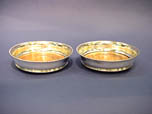 century
they were produced in significantly less quantity and consequently are
much more rare. century
they were produced in significantly less quantity and consequently are
much more rare.
Pairs of coasters are more desirable in the
market place, but one can find single examples of great interest.

Tapering funnels used for decanting wine came into
widespread used from the 1760's, after the introduction of clear, wide-bodied
flint-glass decanters. Known at that time as wine strainers, their purpose
was to strain bits of cork and the sediments thrown by red and fortified
wines such as port and madeira.
 Wine
funnels are composed of an urn shaped bow top with a perforated section
in the center. Under this section fits a straight, tapering tube which
ends in a curve so that the wine runs along the wall of the decanter
for a gentle descent. In this way the clarity of the flowing wine can
be viewed and any excess aeration from a free fall into the decanter
avoided. Wine
funnels are composed of an urn shaped bow top with a perforated section
in the center. Under this section fits a straight, tapering tube which
ends in a curve so that the wine runs along the wall of the decanter
for a gentle descent. In this way the clarity of the flowing wine can
be viewed and any excess aeration from a free fall into the decanter
avoided.
18th century examples of funnels
tend to be a trifle smaller and more delicate than those made in the
19th century.
|

Used as early as the 14th century
B.C. in Minoan Crete the saucer-shaped taster has been essential in
the production of wine right to the present. In order to 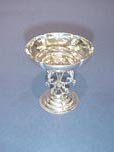 determine
a wine's quality, its color, clarity, bouquet, and taste must be assessed. determine
a wine's quality, its color, clarity, bouquet, and taste must be assessed.
The familiar saucer-shaped
French taster (or tastevin) with its concave and convex surface irregularities
in the guise of decoration provide reflective surfaces to view the
wine and a convenient form to taste it. Silver is invariably the material
of choice because it is resilient and reflective. Owners often engraved
their names and vineyards on their tasters whose single flat handles
often accommodated a neck cord. Wine professionals value their tasters
as both working and ceremonial accoutrements.
|
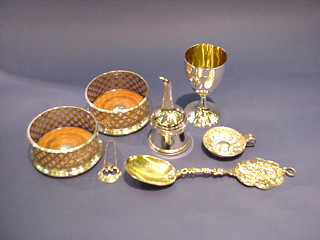
Pair Sheffield Plate Coasters.
c. 1840. $1475.
Funnell. London, 1816, S. Hougham. $2450.
Goblet. London, 1813, Jos. Dobbs. $1650.
Taste-Vin. France, c.1820 (Well-Loved!) $695.
Master Tasting Spoon. Gilded, Tiffany & Co., c. 1890.
$1950
|
